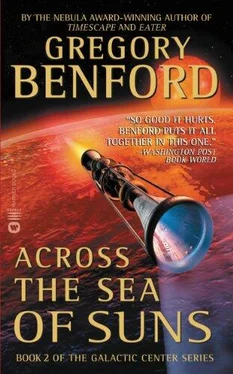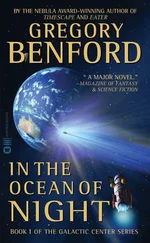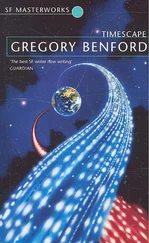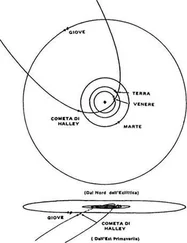Gregory Benford - Across the Sea of Suns
Здесь есть возможность читать онлайн «Gregory Benford - Across the Sea of Suns» весь текст электронной книги совершенно бесплатно (целиком полную версию без сокращений). В некоторых случаях можно слушать аудио, скачать через торрент в формате fb2 и присутствует краткое содержание. Год выпуска: 2007, ISBN: 2007, Издательство: Grand Central Publishing, Жанр: Космическая фантастика, на английском языке. Описание произведения, (предисловие) а так же отзывы посетителей доступны на портале библиотеки ЛибКат.
- Название:Across the Sea of Suns
- Автор:
- Издательство:Grand Central Publishing
- Жанр:
- Год:2007
- ISBN:978-0-446-50634-2
- Рейтинг книги:3 / 5. Голосов: 1
-
Избранное:Добавить в избранное
- Отзывы:
-
Ваша оценка:
- 60
- 1
- 2
- 3
- 4
- 5
Across the Sea of Suns: краткое содержание, описание и аннотация
Предлагаем к чтению аннотацию, описание, краткое содержание или предисловие (зависит от того, что написал сам автор книги «Across the Sea of Suns»). Если вы не нашли необходимую информацию о книге — напишите в комментариях, мы постараемся отыскать её.
Across the Sea of Suns — читать онлайн бесплатно полную книгу (весь текст) целиком
Ниже представлен текст книги, разбитый по страницам. Система сохранения места последней прочитанной страницы, позволяет с удобством читать онлайн бесплатно книгу «Across the Sea of Suns», без необходимости каждый раз заново искать на чём Вы остановились. Поставьте закладку, и сможете в любой момент перейти на страницу, на которой закончили чтение.
Интервал:
Закладка:
She breathed in the air with obvious relish. It was better here, near the plants and algae vats. If you closed your eyes you could very nearly think you were in a genuine forest. You could blot out the muted bass rumble of the unending fusion flame.
“Nigel, it seems so long ,” she said suddenly, plaintively.
He nodded. Twelve years since Lancer fired its drop-away accelerators and boosted achingly up to light speed. He took her hand and squeezed. They had all passed the vast tracts of time with their work, with study, with experiments like the Slowslots, with astronomical observations. But the years had weight and presence.
Lancer was a rush job.
In 2041 a giant radio net, laced across the far side of the Moon, picked up an odd signal. It was a weak, shifting pattern, amplitude-modulated. It came in sharp at 120 megahertz, smack in the middle of the commercial radio band. Originally, the farside radio grid had been strung to carry out astrophysical studies in the low-frequency range, down to the 10 kilohertz region. The designers at Goldstone, Bonn and Beijing had only recently installed gear to take the system up into the megahertz range, because the jammed commercial bands were so noisy now that sensitive astrophysical work was impossible from Earth’s surface. The Moon made an effective shield.
The emission pattern had, as the jargon went, significant nonrandom elements. Patterns would rise out of the galactic background radio noise and then, before the sequence of amplitude modulations could form a coherent pattern, the dim electromagnetic tremor faded.
The most likely explanation was some intermittent natural process, perhaps resembling Jupiter’s decametric sputtering. That radiation came from electron swarms in Jupiter’s magnetic belts. Waves passing through the belts made the electrons bunch together, so that they radiated like a natural antenna. Jupiter’s emissions had wavelengths hundreds of meters long, well below the megahertz range. To explain these new emissions, astronomers invoked a gas giant planet with much stronger magnetic fields, or higher electron densities.
When they pinpointed the source, this model made sense. It was BD +36°2147, a dim red star 8.1 light-years away, and it seemed to have a large planet. This was somewhat embarrassing.
The funding agency, ISA, wondered why a star that close had not been checked routinely for unusual emissions. An obvious explanation was that the action and the grants were in high-energy, spectacular objects—pulsars, quasars, radio jets. Also, the small, red stars were boring. They were hard to see and they led dull lives. BD +36°2147 had never been named. The scramble of letters and numbers simply meant that the star had appeared first in the Bonner Durchmeisterung catalog in the nineteenth century. The declination angle was +36 degrees and 2147 was a serial number in the catalog, related to the star’s other coordinate, Right Ascension,
From the star’s slight wobble, one could deduce that something large and dark was revolving around it. That was a perfectly logical candidate for the superJovian. Orbital optical telescopes had by this time found hundreds of dark companions around nearby stars, proving that planetary systems were fairly common, and ending a centuries-old argument.
The first unsettling fact came to light when ISA poked around in the old survey reports from Earth-based radio telescopes. It turned out that BD +36°2147 had been observed, repeatedly. There had been no detectable emission. The present radio waves must have started sometime in the last three years.
The second surprise came along a few months later. For one rare two-minute interval, a strong wave pattern got through. The amplitude-modulated signal was a carrier wave, just like commercial AM radio. Filtered and speeded up and fed to an audio output, it quite clearly said the word “and.” Nothing more. A week later, another three minute portion said “Nile.” The big radio ear was now cupped continuously at BD +36°2147. Seven months later it picked up “after.”
The words came through with aching slowness. Some radio astronomers argued that this might be an odd way of cost cutting. As the signal faded in and out, a listener missing a piece of a long sound could still recognize the word. But this theory did not explain why the signal blurred and shifted so frustratingly. It was as though the distant station started transmitting one word and then changed to another before the first was finished.
The signals continued, occasionally coughing forth a fragment, a word, a syllable—but never enough for a clear message. Still, they had to be artificial. That killed the super Jovian magnetosphere theory. They kept to a fairly sharp frequency, though, and this proved useful.
Eight months of careful observations picked up a Doppler shift in the frequency. The shift repeated every twenty-nine days. The logical explanation was that the scattered pulses came from a planet, and that planet moved alternately toward and away from Earth as it orbited the red dwarf star. Optical observations fixed the star’s luminosity, and reliable theory then could give the star’s probable mass. It was 0.32 solar masses, an M2 star. Given the twenty-nine-day “year” of the planet, and the dwarf’s mass, Newton’s laws said the planet was nine times closer to its cool star than Earth was to the sun.
That was as far as observations from near-Earth could go. The radio teams spent years trying to see a Doppler shift from the revolution of the planet itself. It wasn’t there, but nobody expected it to be. A planet that close to its star would be locked with one face eternally sunward, due to the tidal tug between them. Earth’s Moon and the Galilean satellites of Jupiter were tide-locked to their planets, after all. Mercury would be locked toward the sun, but for the competing pull from the other planets.
But tide-locked worlds were deadly. Everybody knew that. One side would be seared and the other frozen. Who could survive such a place and erect a radio transmitter? Did they only live in the twilight band?
The only way to find out was to go and see. In 2029, ISA launched small relativistic probes on near-recon missions to BD +36°2147. One failed in a burst of gamma rays 136 light-years from Earth. The inboard diagnostics told a lot about the flare-up in the fusion burn, before the ship disintegrated. ISA adjusted the burn in the second probe and it survived, to dive past the BD +36°2147 system at 0.99 light speed.
It spotted a gas giant in the right place to cause the star’s wobble, as seen from Earth. But the radio mumble came from an Earth-sized world nearer the star. The probe had been programmed to pass near the gas giant, since its orbit could be deduced from BD +36°2147’s slight rhythm. The other planet was exactly on the other side of the red dwarf star when the probe shot through, so the automatic devices, in a mad scramble to readjust, did not get much data.
Small, fast probes were cheap. The International Space Agency favored them. But they couldn’t respond flexibly, and game theory proved they were a bad strategic choice, in the face of unknown risks.
The best posture, the conflict metricians calculated, was reconnaissance in force: Lancer. So the three superpowers used their muscle and appropriated the just-finished Libration Colony project. ISA took the life zone inside the spinning asteroid world, tunneled more rooms in the rock, and added duralith thrust chambers that could bottle a fusion burn. The design was a copy of the Mare Marginis wreck and it worked well. They stirred the soils, planted crops, burrowed hallways, sliced rock, and fine-tuned a miniature ecology inside the hollowed-out ellipsoidal dome.
All this, to fly at velocities a hairline below light. Toward the red beacon of BD +36°2147, now renamed Ra. The word “Nile” in the transmission, while seemingly irrelevant and possibly a mistake—the error bars in the decoding were significant—became a pretext for invoking Egyptian mythology. The transmitting world was named Isis for the goddess of fertility. The outer gas giant was named for her son, Horus. The astronomical community took two years to decide all this, there were letters discussing the matter in the London Times. The engineers, of course, didn’t give a damn.
Читать дальшеИнтервал:
Закладка:
Похожие книги на «Across the Sea of Suns»
Представляем Вашему вниманию похожие книги на «Across the Sea of Suns» списком для выбора. Мы отобрали схожую по названию и смыслу литературу в надежде предоставить читателям больше вариантов отыскать новые, интересные, ещё непрочитанные произведения.
Обсуждение, отзывы о книге «Across the Sea of Suns» и просто собственные мнения читателей. Оставьте ваши комментарии, напишите, что Вы думаете о произведении, его смысле или главных героях. Укажите что конкретно понравилось, а что нет, и почему Вы так считаете.












